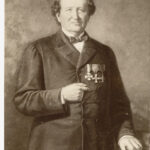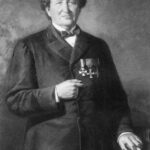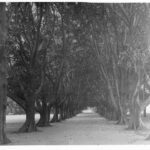Richard Schomburgk was born on 5th October 1811 in Freyburg, Saxony, the son of Johann Friedrich Ludwig Schomburgk, an assistant Lutheran pastor, and his wife Christiane Juliane Wilhelmine (née Krippendorf). He was apprenticed as a gardener at a time when German gardeners held positions of note throughout northern Europe, and from 1840 to 1844 was the botanist on an expedition to British Guiana led by his brother Robert. Returning to Berlin to carry out further research, Richard joined his brother Otto in supporting the liberal cause in the revolutionary year of 1848 and in about December of that year he married Pauline Henriette Kneip of Potsdam. Advised to leave Germany, the brothers and their wives emigrated to South Australia on the Princess Louise, arriving in August 1849 and taking up land at Buchfelde, near Gawler.
In 1865 Richard Schomburgk was appointed as the second Director of the Adelaide Botanic Garden, following the death of George Francis, who had established it in 1855. Schomburgk was in a strong position. The British Guiana expedition had given him an international reputation and sixteen years at Buchfelde had provided practical experience of managing a farm, vines and an orchard under Australian conditions. Although he was not academically brilliant, he was capable, enthusiastic and had good communication skills.
A balanced approach saw him start by improving the rosery and the tropical plant displays, developing animal houses, aviaries and an avenue of Moreton Bay Fig trees, and working on experimental plots of pasture grasses and other utilitarian plants. He combined European traditions with the use of indigenous plants, maintained good relationships with local nurserymen and developed popular features for the public, as well as carrying out scientifically important work.
Up to 300,000 visitors to the Botanic Garden per year were recorded when the population of the whole colony was about 163,000. An early success was the giant water-lily Victoria regia (later Victoria amazonica), which attracted extraordinary attention, with people visiting during their lunch-breaks and hour-by-hour descriptions in the newspapers of the opening of the flowers.
In the prosperous 1870s Schomburgk obtained funds to import a tropical Palm House, opened in 1877. Prefabricated from wrought and cast iron, and technologically advanced for its time, it was designed by Gustav Runge and manufactured in Bremen, Germany. It is now the only one of its kind outside Europe and has recently been restored. In 1884 the Museum of Economic Botany, solidly constructed in classical style, opened to exhibit specimens of economic plants and to house Schomburgk’s herbarium. Unique in Australia, the Museum still retains its original display cases and stencilled ceiling decoration. It displayed plant materials used for cordage, dyes, fibres, timber, resins, oils, beverages and medicines, including plants used by Aboriginal people. Up to 12,000 trees were distributed annually to farmers and civic bodies.
Schomburgk’s success lay in the balance he maintained between the scientific, educational and recreational roles of the Botanic Garden. Visitors enjoyed the walks, vistas, statues and parterre plantings while learning what could be grown under South Australian conditions. His lengthy annual reports included agricultural and viticultural advice, and many people sent specimens from remote parts of the colony for identification. Schomburgk’s own publications ranged from his Reisen [Travels] in Britisch-Guiana (1847-8), two catalogues of plants in the Botanic Garden, papers on pasture grasses, forestry, phylloxera, flower farming, sericulture and rust in cereals, as well as an overview of possible crop plants for the colony.
Richard Schomburgk received several honours from European rulers but above all was honoured locally as ‘the people’s pet’. He died in office on 24th March 1891 and was buried at North Road Cemetery.






Comments